Home / Identifying Where Substitution and Elimination Reactions Happen
SN1/SN2/E1/E2 Decision
Identifying Where Substitution and Elimination Reactions Happen
Last updated: June 24th, 2025 |
Identifying Carbons Where Substitution and Elimination Reactions Can Take Place
- Substitution and elimination reactions need a leaving group in order for them to occur.
- Look for a good leaving group on the substrate undergoing the substitution or elimination reaction.
- If there is no good leaving group, then there won’t be a substitution or elimination reaction. It’s that simple.
- What makes a good leaving group? Review here (See Article: What Makes a Good Leaving Group), but the bottom line is look for halogens and other species that are weak bases.
- Hydroxyl groups (HO-) are poor leaving groups unless acid is present.
- Furthermore, SN1/SN2 and E1/E2 generally only happen on sp3-hybridized carbons.
- sp2-hybridized carbons such as alkenyl, aryl and alkynyl halides will not undergo SN1/SN2/E1/E2
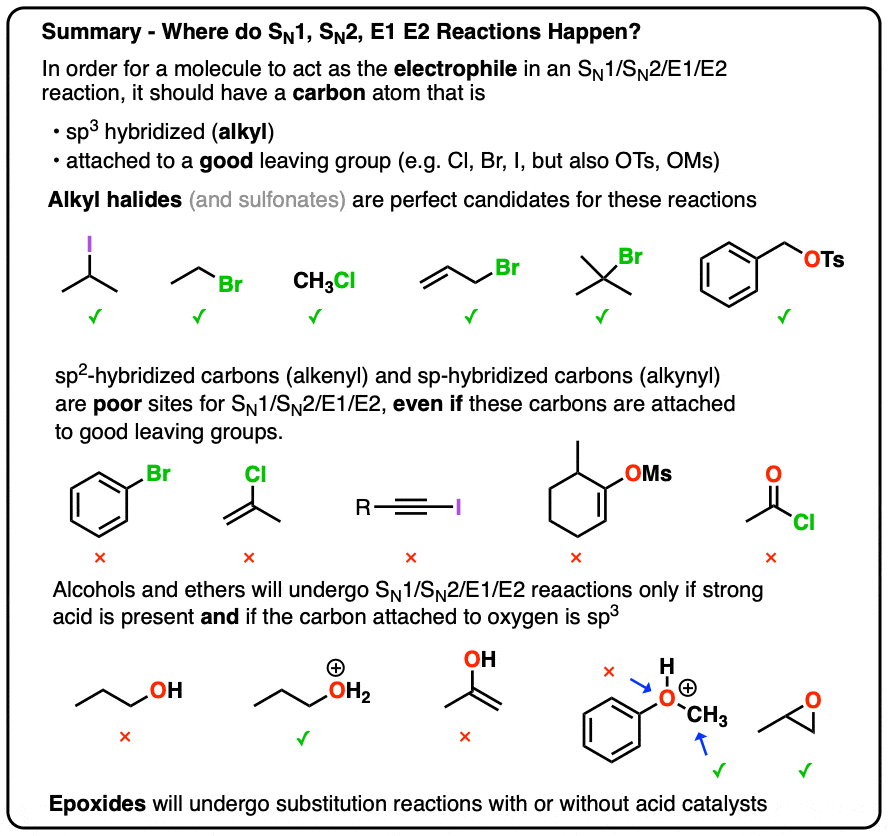
Table of Contents
- Look For A Good Leaving Group On The Substrate
- The Leaving Group Must Be On An sp3 Hybridized Carbon
- Identify The Type of Carbon As Primary, Secondary, or Tertiary
- Acid Makes Alcohols (and Ethers) Into Better Leaving Groups
- Multiple Functional Groups
- Epoxides
- Summary
- Notes
- Quiz Yourself!
- (Advanced) References and Further Reading
1. Look For A Good Leaving Group On The Substrate
This article presumes you are familiar with the SN1, SN2, E1, and E2 reactions. If you need a review on any of these reactions, please follow these links and then come back.
In nucleophilic substitution reactions, the substrate or electrophile (an electron-pair acceptor, e.g. an alkyl halide) undergoes attack by a nucleophile (the electron-pair donor). A new carbon-nucleophile bond forms, and a carbon-leaving group bond breaks off from the substrate.
In elimination reactions, a base breaks a C-H bond on the substrate, and a new C-C pi bond forms, with the breaking of a carbon-leaving group bond from the substrate.
Both of these reactions require the loss of a leaving group from the substrate (i.e. the molecule which is accepting a lone pair from the nucleophile, or is being deprotonated by a base).
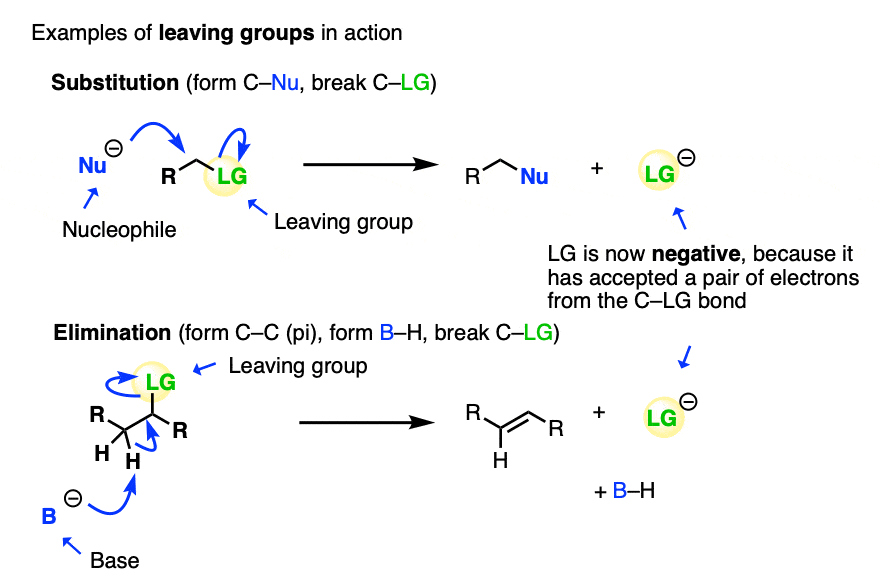
If there’s no good leaving group on the substrate… then no substitution or elimination reaction can happen! It’s that simple.
Common examples of good leaving groups are species that can be weak bases once they accept a lone pair of electrons:
- Halogens (Cl, Br, I, but not F, as the C-F bond is very strong)
- Sulfonates [OTs or OMs]
- Acyloxy groups (O-C(O)R)
- Positively charged groups containing oxygen [OH2 (+), OH(R)(+)], nitrogen [NR3(+)], or even sulfur [SR2(+)]
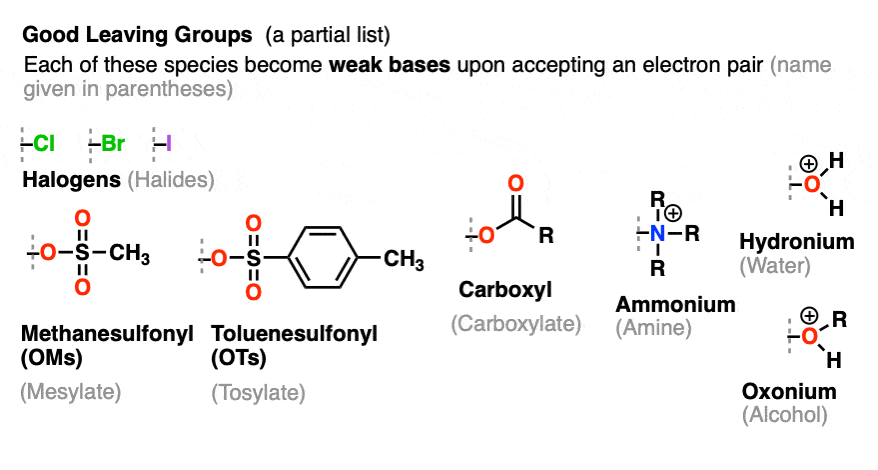
(There is an excellent correlation between low pKa and leaving group ability of the conjugate base. For more on this, see article: What Makes A Good Leaving Group?)
Examples of poor leaving groups include strong bases such as hydroxide (HO–), alkoxides, amides (NH2–)hydride (H–) and carbanions (R–). The fluoride ion (F–) also tends to be a poor leaving group in substitution and elimination reactions since it forms extremely strong bonds to carbon. [Note 1] The cyano group (CN) is a weak base but does not tend to act as a leaving group in substitution or elimination reactions. [Note 2]
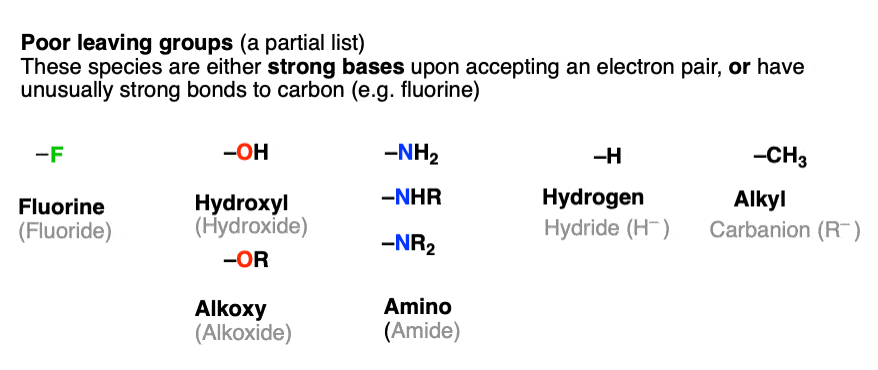
So the first order of business in determining the product of any of these reactions is to identify the site(s) on the substrate where there is a good leaving group.
In other words, look for groups that will be weak bases when they accept a lone pair of electrons.
Not all molecules are capable of substitution or elimination!
For example, hydrocarbons do not act as substrates in SN1/SN2 or elimination reactions because the leaving groups would have to be the extremely strong bases H(-) or alkyl anions (e.g. CH3(-) ).
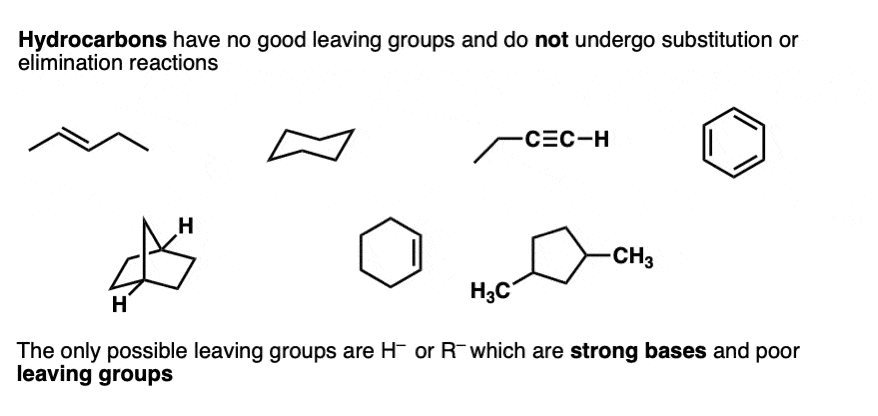
Some hydrocarbons can act as nucleophiles in substitution and elimination reactions, but that’s different than being the substrate. (See post: Acetylides from Alkynes And Their Use In Substitution Reactions)
These exercises give you the challenge of identifying sites on a molecule where substitution or elimination can occur.
If you identify the leaving group, then you are identifying at least one of the bonds that will break. You are halfway there!
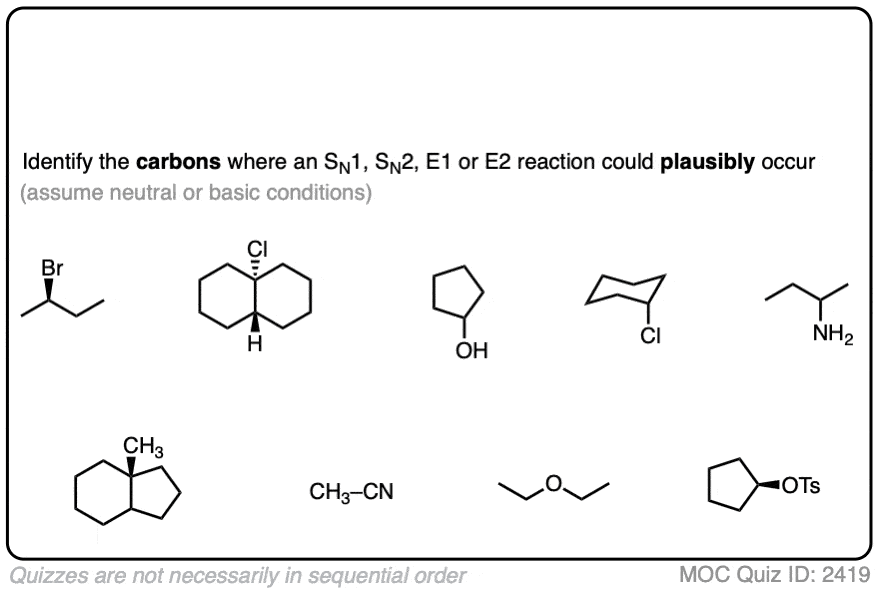 Click to Flip
Click to Flip
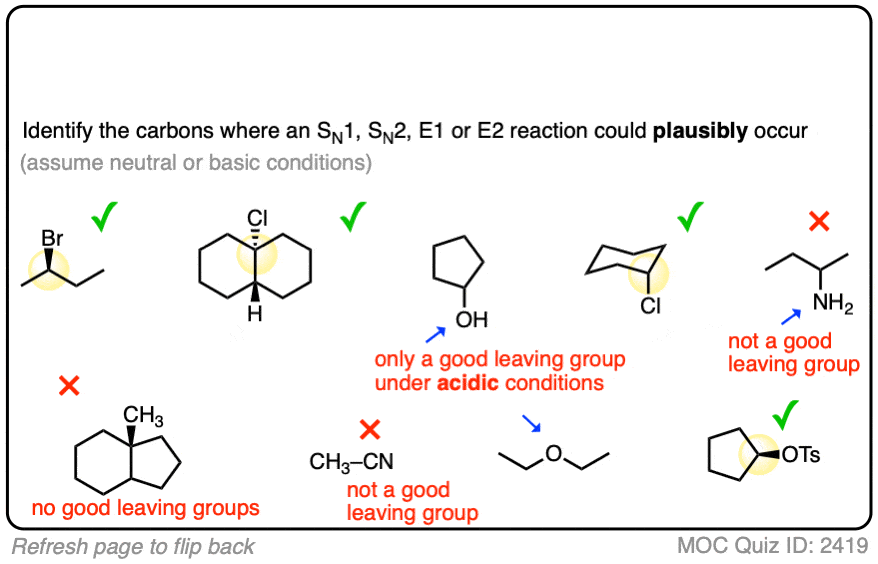
Here’s another set of examples.
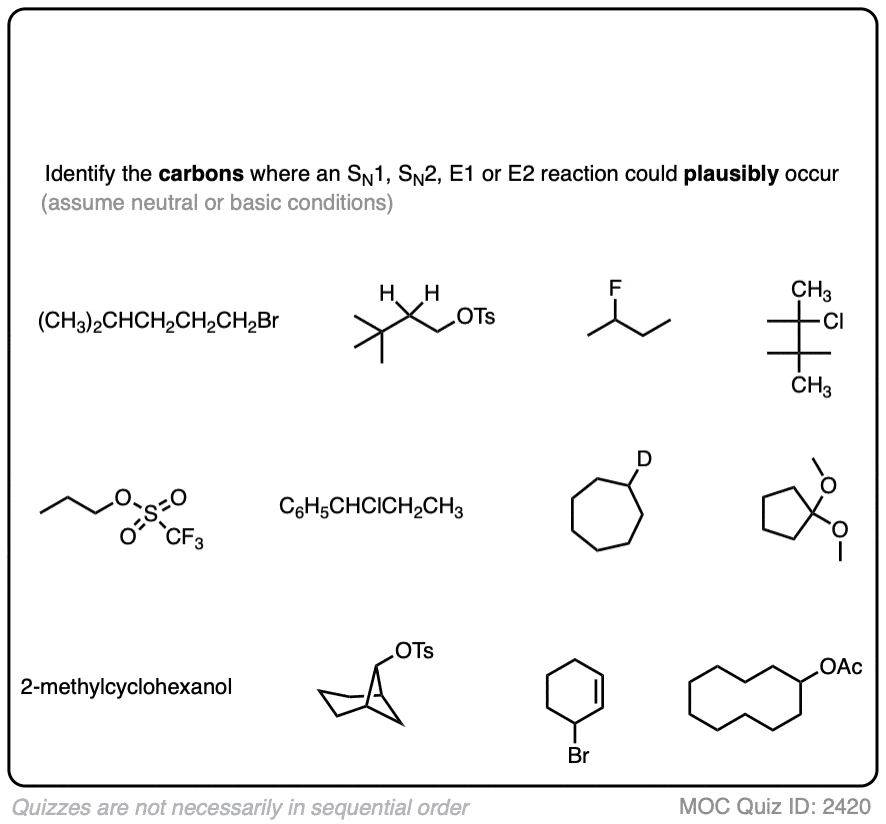 Click to Flip
Click to Flip
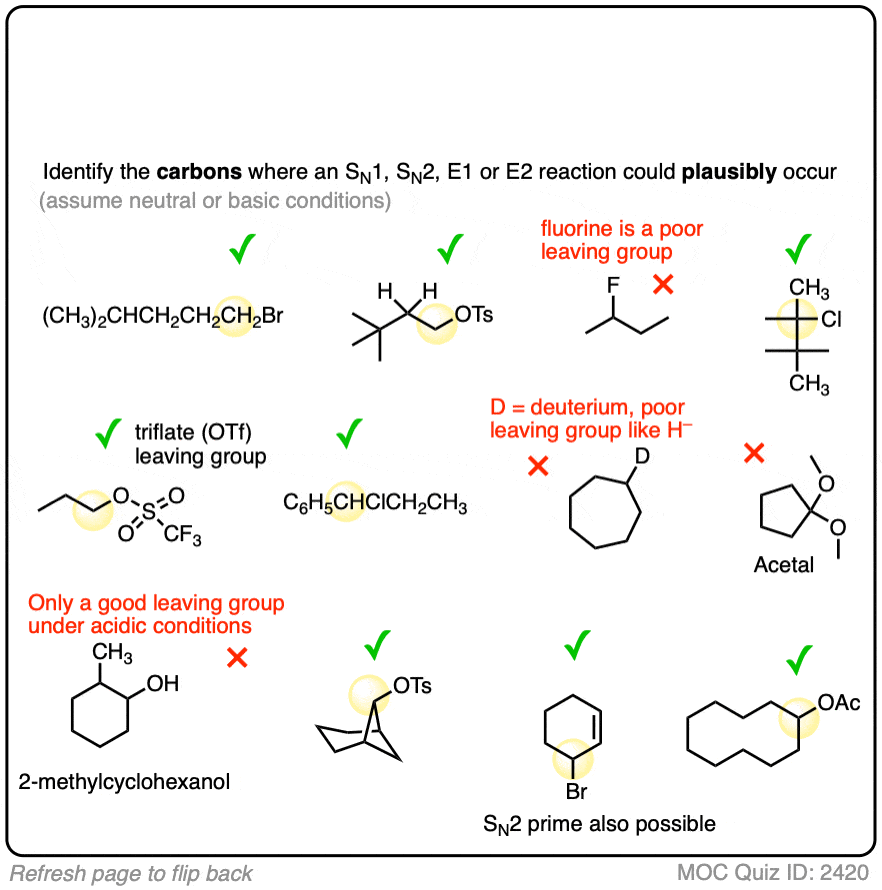
As these quizzes should hopefully have driven home, you want to look for halogens, sulfonates, or other species that will be weak bases once they depart from the substrate.
Some groups that are poor leaving groups can be made into better leaving groups through the addition of acids. More on that below.
2. The Good Leaving Group Should Be Attached To An sp3 Hybridized Carbon
In substitution and elimination reactions, the transition state generally involves the formation of partial positive charge at the carbon bearing the leaving group.
Carbocations are most stable when they are formed through the loss of a leaving group on an sp3-hybridized carbon. Removing a leaving group from an sp2 or sp-hybridized carbon is very difficult, since the greater s-character means the electrons are held closer to the nucleus. [See article: Carbocation Stability] [Note 3]
So another key to identifying where a nucleophilic substitution or elimination reaction will occur is to examine the carbon attached to the good leaving group.
- If the leaving group is attached to an sp3 hybridized carbon, then this is a good candidate for the site of the reaction.
- If it is attached to an sp2 or sp hybridized carbon, then it is unlikely to undergo nucleophilic substitution or elimination.
In this exercise, identify the carbon atoms which are capable of undergoing substitution or elimination.
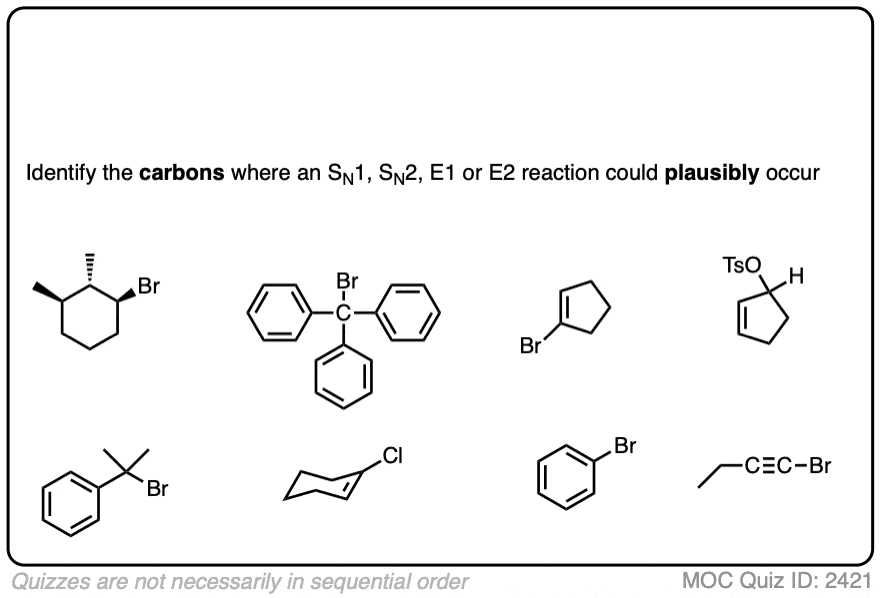 Click to Flip
Click to Flip

Here is another set of examples.
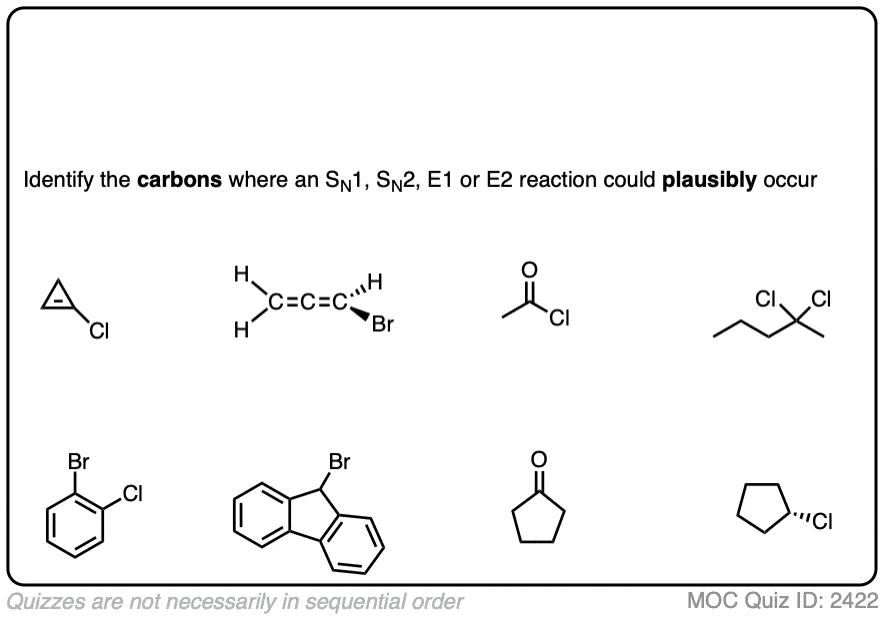 Click to Flip
Click to Flip
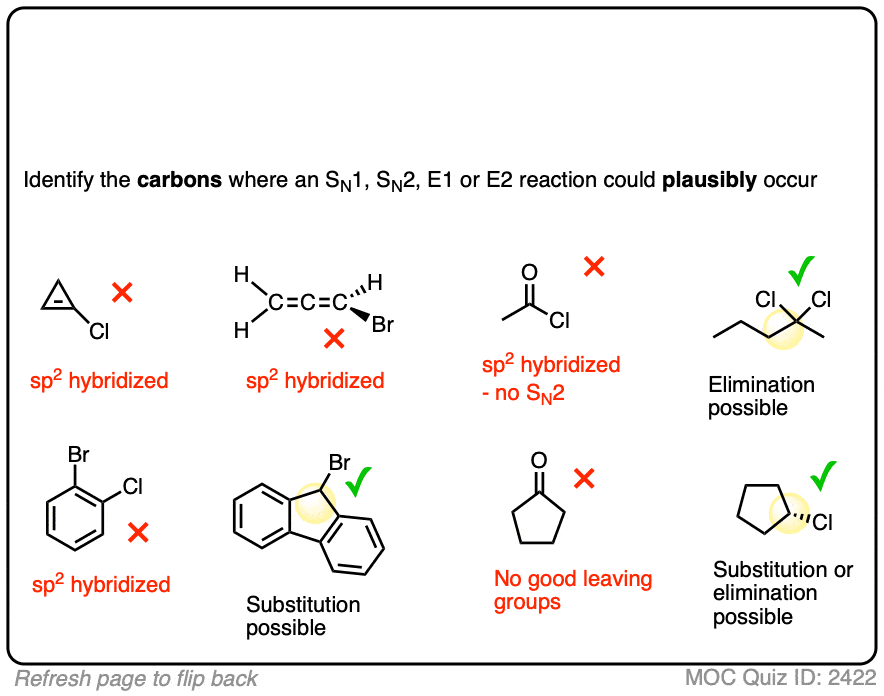
It’s important to know the few exceptions. [Note 4] Elimination to give alkynes occurs on sp2 hybridized carbon using the extremely strong base NaNH2. [See article: Alkynes via Elimination Reactions]. Another exception, more common in advanced courses, is a reaction related to the SN2 called the SN2-prime (SN2′) where formation of C-Nu and breakage of C-LG is accompanied by the shifting over of a C-C pi bond. [Note 5]
3. Identify The Carbon Attached To The Leaving Group As Primary, Secondary or Tertiary
Once a plausible site for substitution or elimination has been found, the next step is to be able to classify that carbon as primary, secondary or tertiary.
Why is this important? Because it will greatly help in determining whether a reaction proceeds via SN1, SN2, E1 or E2 pathway.
I have more to say on this in the subsequent article (See article: SN1/SN2/E1/E2 – The Substrate)
 Click to Flip
Click to Flip
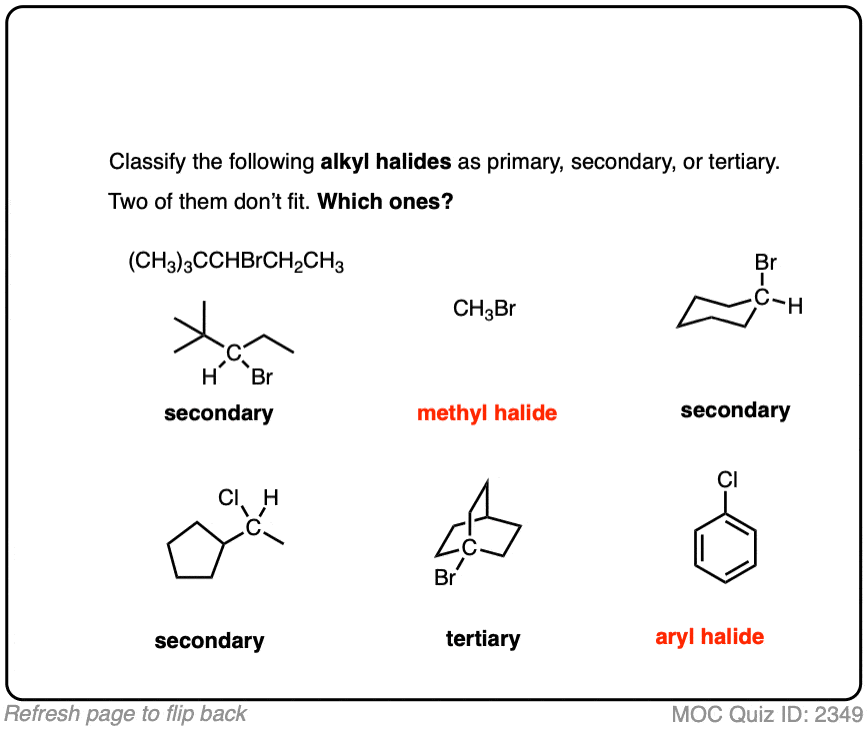
Here is another quiz:
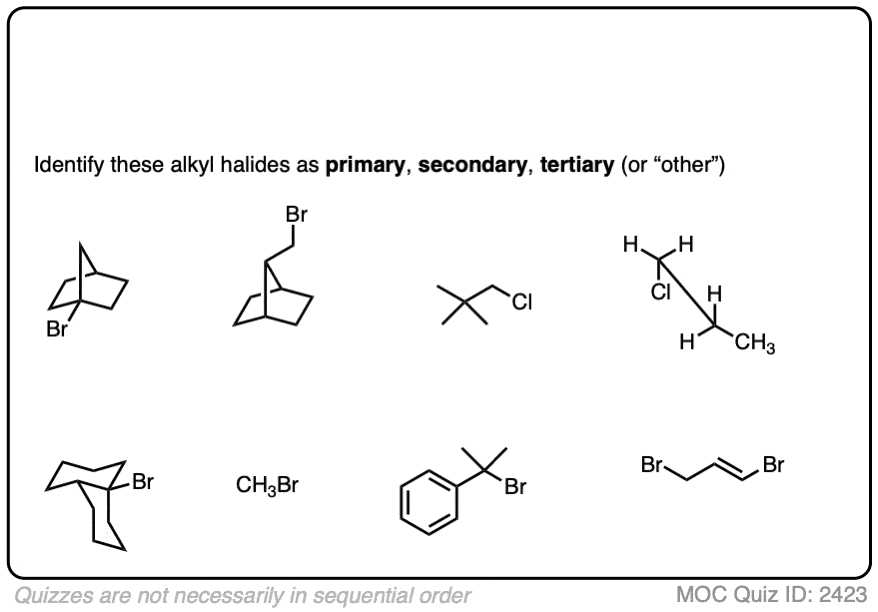 Click to Flip
Click to Flip

4. Alcohols And Ethers Can Participate In Substitution and Elimination Reactions If Acid Is Present
If you have made it this far, and have not covered alcohols or epoxides, then you are probably ready to proceed to the next article.
If you are covering the substitution and elimination reactions of alcohols and ethers, however, you’ll need to know another important twist.
Hydroxyl groups (OH) are poor leaving groups in substitution and elimination reactions. Unless strong acid is present, in which case they can be protonated to give their conjugate acids. (See article: The Conjugate Acid Is A Better Leaving Group)
How do you know if the alcohol or ether might be protonated? Look for strong acids such as HCl, HBr, HI, H2SO4 or TsOH.
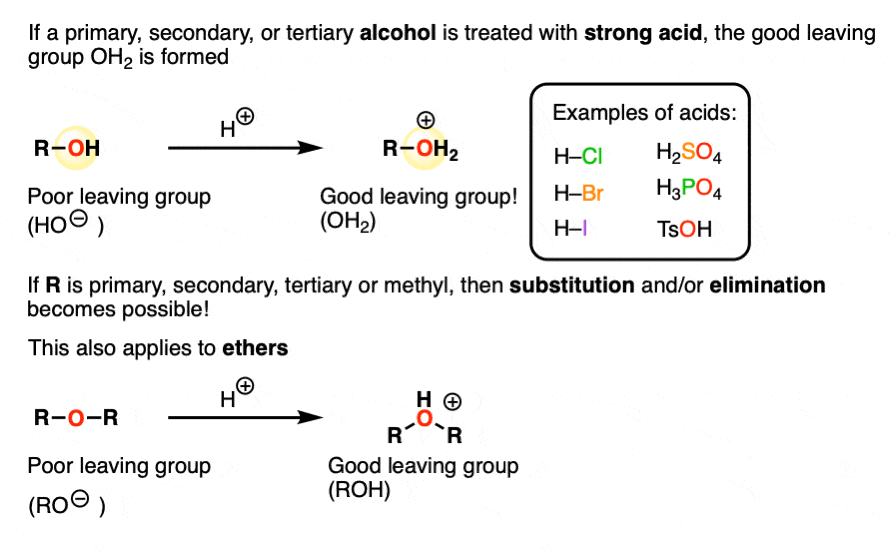
The restriction that substitution and elimination reactions only happen on sp3 hybridized carbons still applies, however.
See if you can identify the carbons in each case which can undergo substitution or elimination reactions.
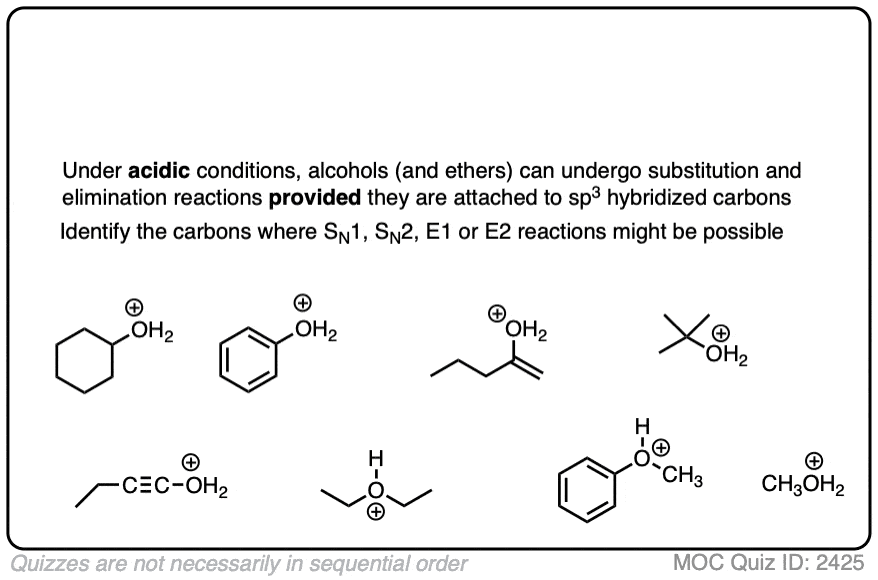 Click to Flip
Click to Flip
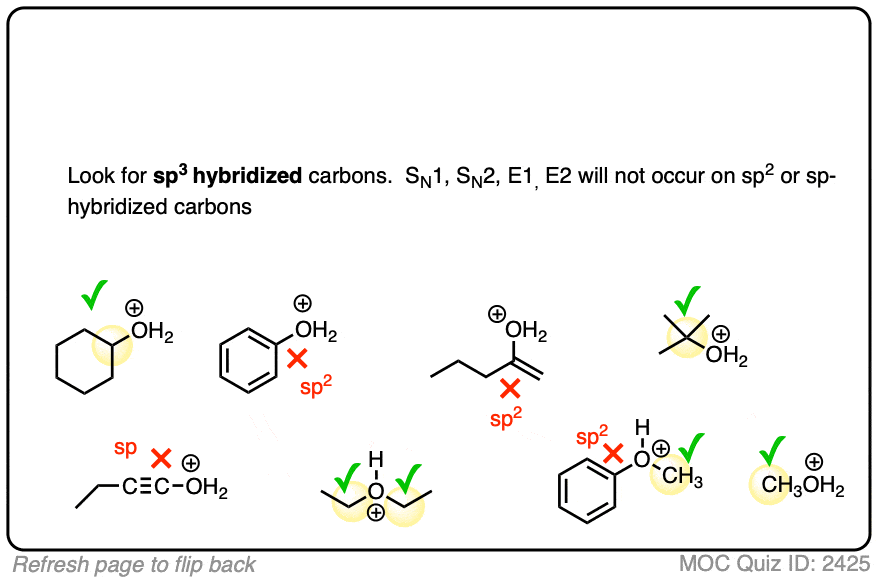
As a side note, positively-charged sulfur, nitrogen and even phosphorus can also be good leaving groups. The leaving group in these cases are neutral amines (NR3) sulfides (SR2) or phosphines (PR3).
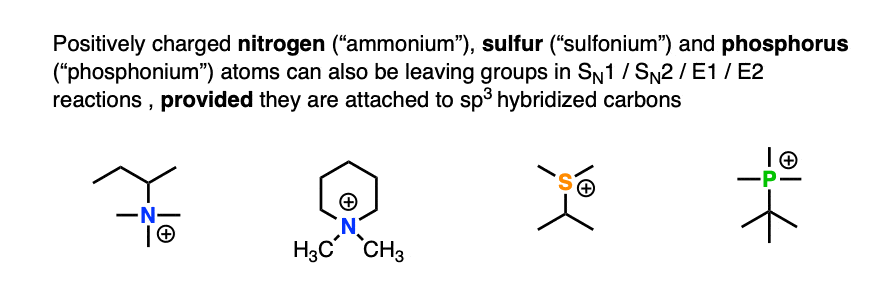
5. Situations With Two Leaving Groups
There are times where you will be presented with cases where multiple good leaving groups are present, and your challenge will be to find the one site on the molecule where substitution or elimination is most likely to occur.
As we saw before, look for a good leaving group attached to an sp3 hybridized carbon.
 Click to Flip
Click to Flip

You might see other groups like OH, NH2, or SH in addition to the good leaving group. Those are likely nucleophiles that will react with the substrate via an intramolecular substitution reaction. (See article: Intramolecular SN2 Reactions)
6. Epoxides
Epoxides are a special case of ethers that will undergo substitution reactions without the addition of acid. That is due to the considerable ring strain of the three-membered ring (See article: Epoxide Ring-Opening With Base).
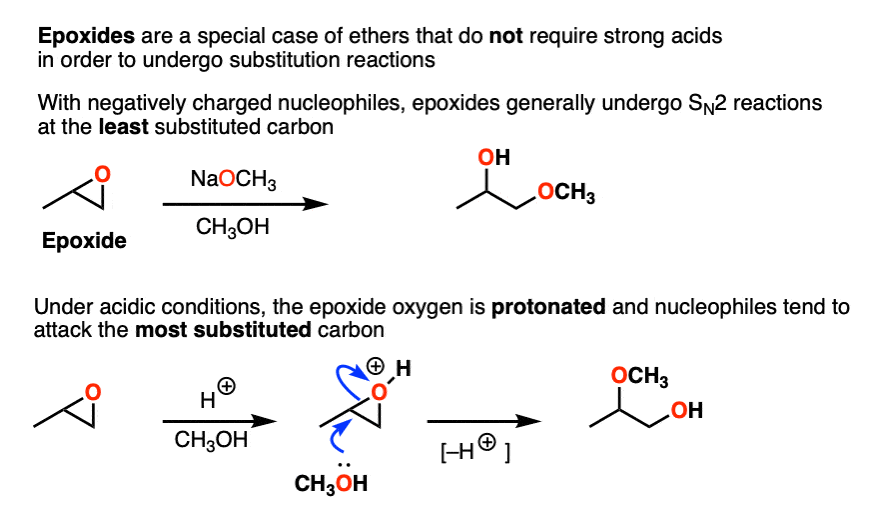
7. Summary
In summary, the process for identifying where SN1/SN2/E1/E2 reactions happen looks like this.
- Identify good leaving groups (such as halides, but also OTs and OMs, among others)
- … that are attached to sp3 (alkyl) hybridized carbons.
- Additionally, alcohols and ethers can undergo SN1/SN2/E1/E2 if strong acid is present.
The next step is to identify the carbon bearing the leaving group as primary, secondary, or tertiary. That will help to narrow down whether the reaction will participate in an SN1, SN2, E1 or E2 reaction. More on that in the next post.
Next Post: Deciding SN1/SN2/E1/E2 – The Substrate
Notes
Related Articles
- Deciding SN1/SN2/E1/E2 (1) – The Substrate
- What makes a good leaving group?
- Acetylides from Alkynes, And Substitution Reactions of Acetylides
- The SN1 Mechanism
- The SN2 Mechanism
- The E1 Reaction
- The E2 Mechanism
- Primary, Secondary, Tertiary, Quaternary In Organic Chemistry
- SN1 vs E1 and SN2 vs E2 : The Temperature
- Deciding SN1/SN2/E1/E2 (2) – The Nucleophile/Base
Note 1 – The bond dissociation energy of fluorine in CH3F is about 109 kcal/mol, even larger than the C-H bond dissociation energy (104 kcal/mol).
Note 2 – Despite being a weak base (the pKa of HCN is 9.2) the cyanide ion does not act as a good leaving group in SN2 reactions for reasons similar to that for fluoride ion; the C–CN bond is just too strong. (One estimate is that the reaction is unfavorable by about 15 kcal/mol, which makes displacement of CN(-) very unlikely)
In fact, methyl cyanide, more commonly known as acetonitrile, is a commonly used polar aprotic solvent for SN2 reactions.
Note 3 – Why do SN1/SN2/E1/E2 reactions happen only on alkyl halides and not on alkenyl or alkynyl halides?
Here’s one way to look at it.
Remember how s-orbitals are held closer to the nucleus, which is why acetylide ions are more stable than alkyl anions? You can think of alkenyl and alkynl carbons as having a great effective electronegativity than alkyl carbons, which makes them “hold on” to electrons more tightly and making it more difficult for an electron pair to leave.
So in other words, alkenyl and alkynyl carbons form stronger bonds.
Another, related explanation has to do with the relative abilities of carbon to stabilize positive charge as the amount of s-character increases.
The E1 and SN1 reactions go through carbocations, whereas the SN2 reaction requires a partially-positive charged carbon in the transition state.
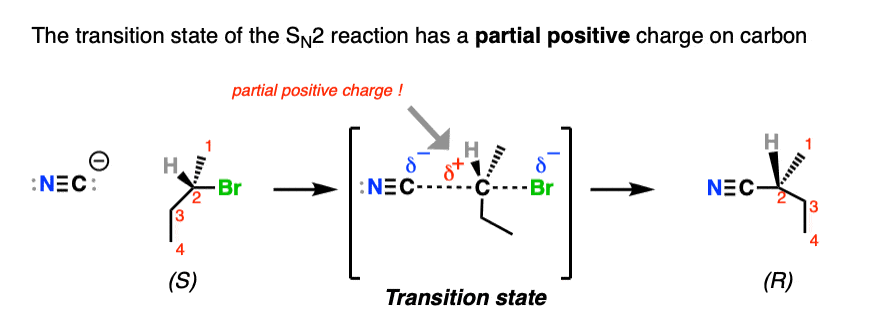
So each of these reactions involves a transition state where the central carbon bears a partial positive charge.
If you recall that the ability to stabilize a lone pair of electrons increases as s-character increases (sp3 < sp2 < sp ) then think of the trend in the opposite direction; the ability of a carbon to stabilize a positive charge decreases as s-character increases, as the empty orbital is held closer to the positively charged nucleus.
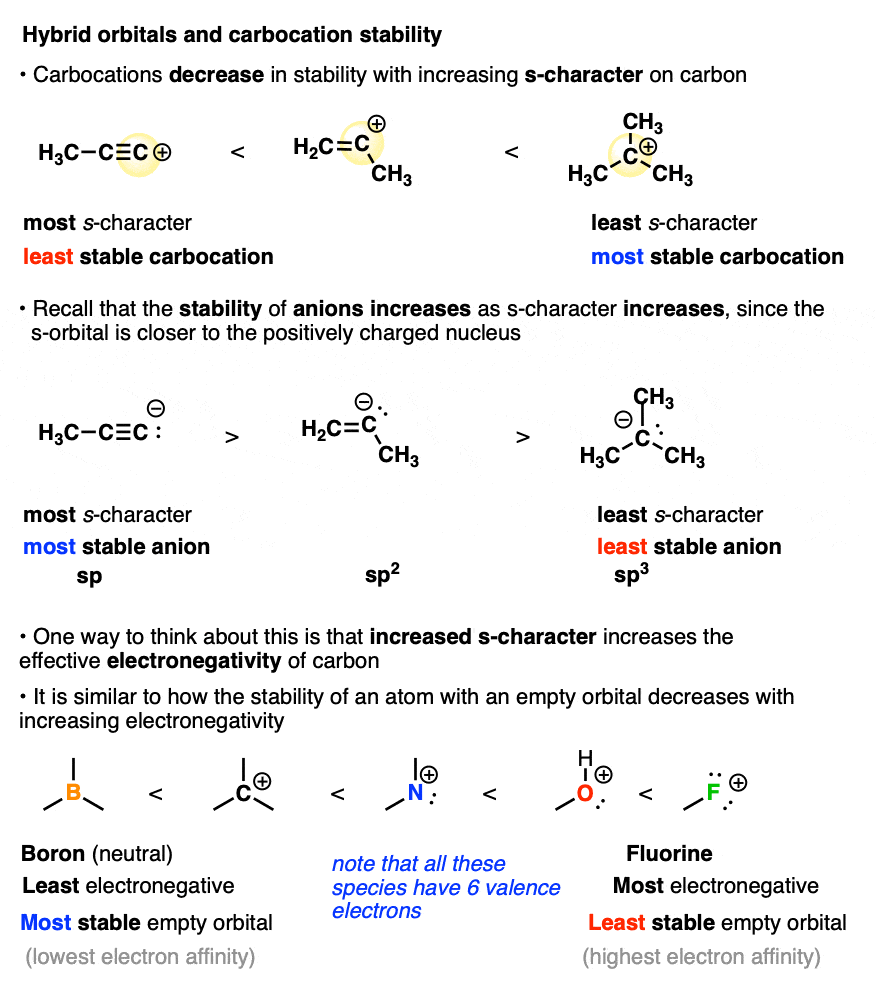
For more on the stability of carbocations, see this post on Carbocation Stability.
Note 4 -One exception to the “no SN1/SN2/E1/E2 on sp2 hybridized carbons” is formation of alkynes from alkenyl halides via use of the extremely strong base NaNH2. See article – Synthesis of Alkynes via Elimination of Alkenyl Halides
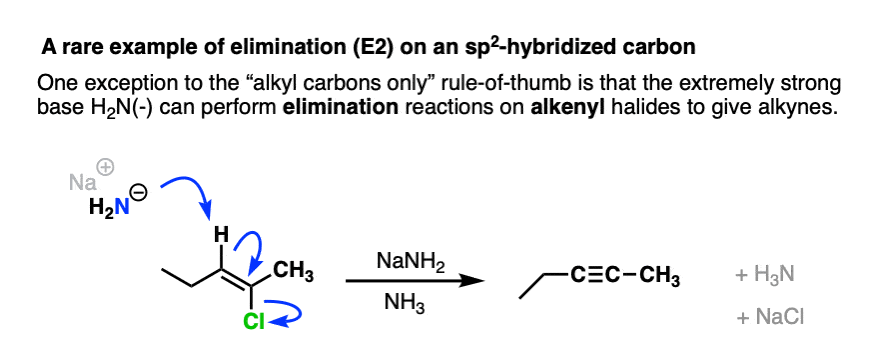
Note 5. Another exception to the “no SN1/SN2/E1/E2 on sp2 hybridized carbons” is found in a reaction known as the SN2-prime (SN2′) reaction. It’s similar to the SN2 in that it is concerted and bimolecular, but slightly different in that the attack does not occur directly on the sp2-hybridized alkyl halide.
It’s not a reaction that comes up too much in introductory organic, but a good exam question.
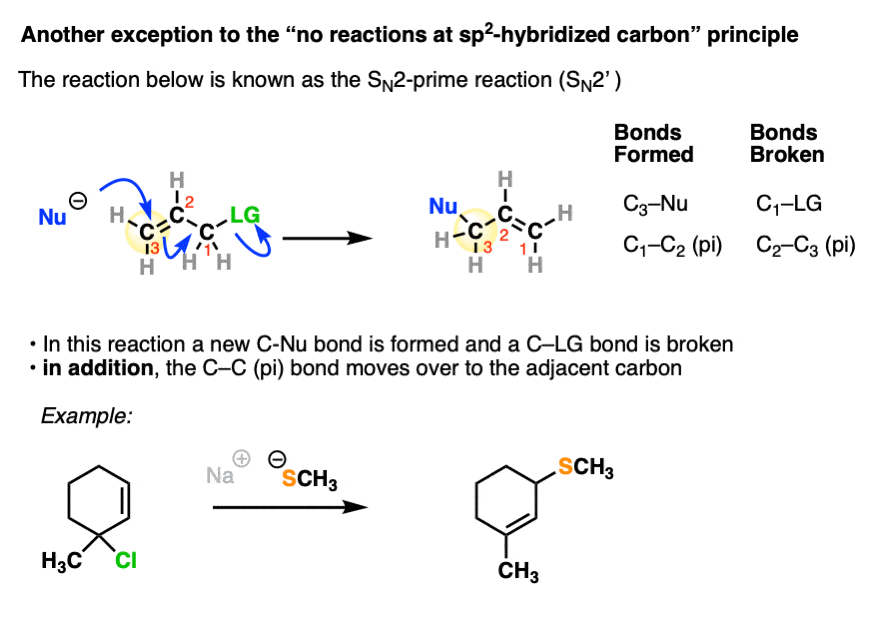
Quiz Yourself!
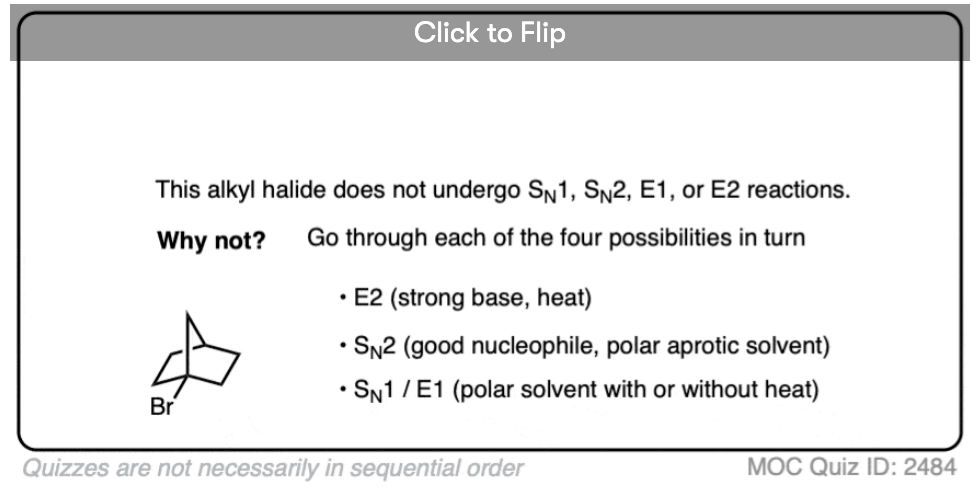
Become a MOC member to see the clickable quiz with answers on the back.

Become a MOC member to see the clickable quiz with answers on the back.

Become a MOC member to see the clickable quiz with answers on the back.
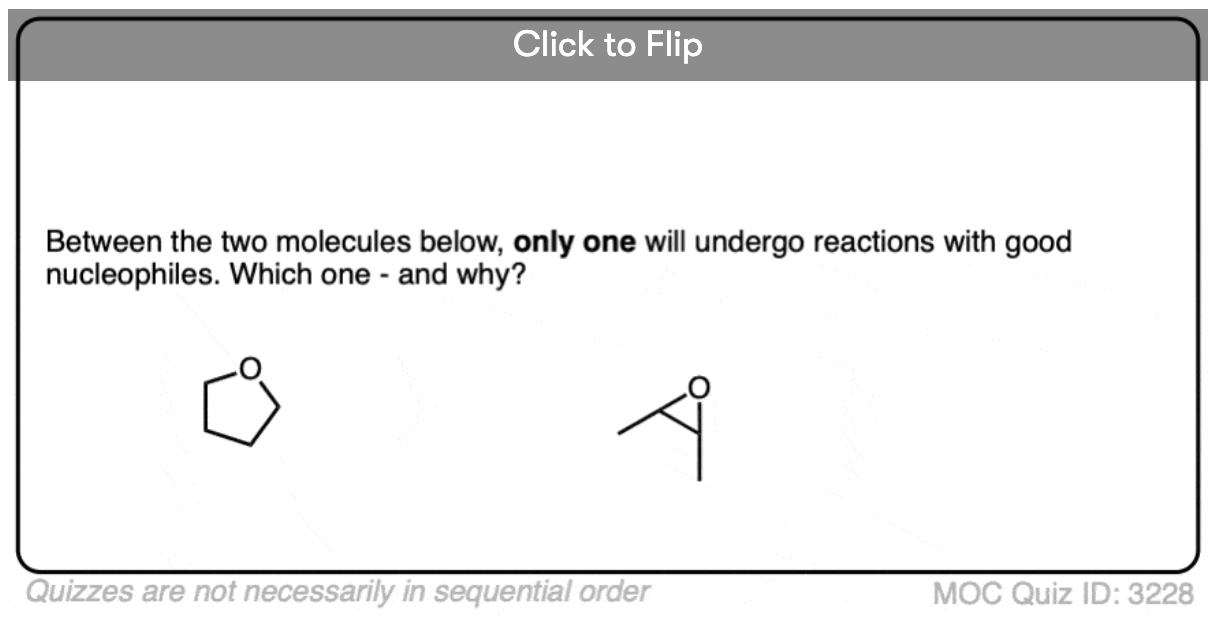
Become a MOC member to see the clickable quiz with answers on the back.

Become a MOC member to see the clickable quiz with answers on the back.
(Advanced) References and Further Reading
In Streitweiser’s Solvolytic Displacement Reactions, page 31, :
[According to calculations] the reaction of methyl bromide with hydroxide ion is exothermic by 16 kcal/mol. The equivalent increase in the activation energy of the reverse reaction corresponds to a factor of 10-12 in rate; i.e. the rate is far too slow to be observed. Since the reactions of alkyl halides with ethoxide, phenoxide, acetate, hydrosulfide, cyanide, thiosulfate and sulfite ions are all exothermic by 10-20 kcal, the reverse reactions will be slower by factors of 10-7 to 10-14 and will, therefore, not be observed except under the most exceptional conditions.”
- Mechanism of ionic reactions. The heat of ionic substitution reactions
R. A. Ogg
Trans. Faraday Soc., 1935,31, 1385-1392
DOI: 10.1039/TF9353101385
Measurement of the heats of reaction for some simple nucleophilic substitution reactions of alkyl halides with various nucleophiles.
00 General Chemistry Review
01 Bonding, Structure, and Resonance
- How Do We Know Methane (CH4) Is Tetrahedral?
- Hybrid Orbitals and Hybridization
- How To Determine Hybridization: A Shortcut
- Orbital Hybridization And Bond Strengths
- Sigma bonds come in six varieties: Pi bonds come in one
- A Key Skill: How to Calculate Formal Charge
- The Four Intermolecular Forces and How They Affect Boiling Points
- 3 Trends That Affect Boiling Points
- How To Use Electronegativity To Determine Electron Density (and why NOT to trust formal charge)
- Introduction to Resonance
- How To Use Curved Arrows To Interchange Resonance Forms
- Evaluating Resonance Forms (1) - The Rule of Least Charges
- How To Find The Best Resonance Structure By Applying Electronegativity
- Evaluating Resonance Structures With Negative Charges
- Evaluating Resonance Structures With Positive Charge
- Exploring Resonance: Pi-Donation
- Exploring Resonance: Pi-acceptors
- In Summary: Evaluating Resonance Structures
- Drawing Resonance Structures: 3 Common Mistakes To Avoid
- How to apply electronegativity and resonance to understand reactivity
- Bond Hybridization Practice
- Structure and Bonding Practice Quizzes
- Resonance Structures Practice
02 Acid Base Reactions
- Introduction to Acid-Base Reactions
- Acid Base Reactions In Organic Chemistry
- The Stronger The Acid, The Weaker The Conjugate Base
- Walkthrough of Acid-Base Reactions (3) - Acidity Trends
- Five Key Factors That Influence Acidity
- Acid-Base Reactions: Introducing Ka and pKa
- How to Use a pKa Table
- The pKa Table Is Your Friend
- A Handy Rule of Thumb for Acid-Base Reactions
- Acid Base Reactions Are Fast
- pKa Values Span 60 Orders Of Magnitude
- How Protonation and Deprotonation Affect Reactivity
- Acid Base Practice Problems
03 Alkanes and Nomenclature
- Meet the (Most Important) Functional Groups
- Condensed Formulas: Deciphering What the Brackets Mean
- Hidden Hydrogens, Hidden Lone Pairs, Hidden Counterions
- Don't Be Futyl, Learn The Butyls
- Primary, Secondary, Tertiary, Quaternary In Organic Chemistry
- Branching, and Its Affect On Melting and Boiling Points
- The Many, Many Ways of Drawing Butane
- Wedge And Dash Convention For Tetrahedral Carbon
- Common Mistakes in Organic Chemistry: Pentavalent Carbon
- Table of Functional Group Priorities for Nomenclature
- Summary Sheet - Alkane Nomenclature
- Organic Chemistry IUPAC Nomenclature Demystified With A Simple Puzzle Piece Approach
- Boiling Point Quizzes
- Organic Chemistry Nomenclature Quizzes
04 Conformations and Cycloalkanes
- Staggered vs Eclipsed Conformations of Ethane
- Conformational Isomers of Propane
- Newman Projection of Butane (and Gauche Conformation)
- Introduction to Cycloalkanes
- Geometric Isomers In Small Rings: Cis And Trans Cycloalkanes
- Calculation of Ring Strain In Cycloalkanes
- Cycloalkanes - Ring Strain In Cyclopropane And Cyclobutane
- Cyclohexane Conformations
- Cyclohexane Chair Conformation: An Aerial Tour
- How To Draw The Cyclohexane Chair Conformation
- The Cyclohexane Chair Flip
- The Cyclohexane Chair Flip - Energy Diagram
- Substituted Cyclohexanes - Axial vs Equatorial
- Ranking The Bulkiness Of Substituents On Cyclohexanes: "A-Values"
- Cyclohexane Chair Conformation Stability: Which One Is Lower Energy?
- Fused Rings - Cis-Decalin and Trans-Decalin
- Naming Bicyclic Compounds - Fused, Bridged, and Spiro
- Bredt's Rule (And Summary of Cycloalkanes)
- Newman Projection Practice
- Cycloalkanes Practice Problems
05 A Primer On Organic Reactions
- The Most Important Question To Ask When Learning a New Reaction
- Curved Arrows (for reactions)
- Nucleophiles and Electrophiles
- The Three Classes of Nucleophiles
- Nucleophilicity vs. Basicity
- What Makes A Good Nucleophile?
- What Makes A Good Leaving Group?
- 3 Factors That Stabilize Carbocations
- Equilibrium and Energy Relationships
- 7 Factors that stabilize negative charge in organic chemistry
- 7 Factors That Stabilize Positive Charge in Organic Chemistry
- What's a Transition State?
- Hammond's Postulate
- Learning Organic Chemistry Reactions: A Checklist (PDF)
- Introduction to Oxidative Cleavage Reactions
06 Free Radical Reactions
- Free Radical Reactions
- 3 Factors That Stabilize Free Radicals
- Bond Strengths And Radical Stability
- Free Radical Initiation: Why Is "Light" Or "Heat" Required?
- Initiation, Propagation, Termination
- Monochlorination Products Of Propane, Pentane, And Other Alkanes
- Selectivity In Free Radical Reactions
- Selectivity in Free Radical Reactions: Bromination vs. Chlorination
- Halogenation At Tiffany's
- Allylic Bromination
- Bonus Topic: Allylic Rearrangements
- In Summary: Free Radicals
- Synthesis (2) - Reactions of Alkanes
- Free Radicals Practice Quizzes
07 Stereochemistry and Chirality
- Types of Isomers: Constitutional Isomers, Stereoisomers, Enantiomers, and Diastereomers
- How To Draw The Enantiomer Of A Chiral Molecule
- How To Draw A Bond Rotation
- Introduction to Assigning (R) and (S): The Cahn-Ingold-Prelog Rules
- Assigning Cahn-Ingold-Prelog (CIP) Priorities (2) - The Method of Dots
- Enantiomers vs Diastereomers vs The Same? Two Methods For Solving Problems
- Assigning R/S To Newman Projections (And Converting Newman To Line Diagrams)
- How To Determine R and S Configurations On A Fischer Projection
- The Meso Trap
- Optical Rotation, Optical Activity, and Specific Rotation
- Optical Purity and Enantiomeric Excess
- What's a Racemic Mixture?
- Chiral Allenes And Chiral Axes
- Stereochemistry Practice Problems and Quizzes
08 Substitution Reactions
- Nucleophilic Substitution Reactions - Introduction
- Two Types of Nucleophilic Substitution Reactions
- The SN2 Mechanism
- Why the SN2 Reaction Is Powerful
- The SN1 Mechanism
- The Conjugate Acid Is A Better Leaving Group
- Comparing the SN1 and SN2 Reactions
- Polar Protic? Polar Aprotic? Nonpolar? All About Solvents
- Steric Hindrance is Like a Fat Goalie
- Common Blind Spot: Intramolecular Reactions
- Substitution Practice - SN1
- Substitution Practice - SN2
09 Elimination Reactions
- Elimination Reactions (1): Introduction And The Key Pattern
- Elimination Reactions (2): The Zaitsev Rule
- Elimination Reactions Are Favored By Heat
- Two Elimination Reaction Patterns
- The E1 Reaction
- The E2 Mechanism
- E1 vs E2: Comparing the E1 and E2 Reactions
- Antiperiplanar Relationships: The E2 Reaction and Cyclohexane Rings
- Bulky Bases in Elimination Reactions
- Comparing the E1 vs SN1 Reactions
- Elimination (E1) Reactions With Rearrangements
- E1cB - Elimination (Unimolecular) Conjugate Base
- Elimination (E1) Practice Problems And Solutions
- Elimination (E2) Practice Problems and Solutions
10 Rearrangements
11 SN1/SN2/E1/E2 Decision
- Identifying Where Substitution and Elimination Reactions Happen
- Deciding SN1/SN2/E1/E2 (1) - The Substrate
- Deciding SN1/SN2/E1/E2 (2) - The Nucleophile/Base
- SN1 vs E1 and SN2 vs E2 : The Temperature
- Deciding SN1/SN2/E1/E2 - The Solvent
- Wrapup: The Key Factors For Determining SN1/SN2/E1/E2
- Alkyl Halide Reaction Map And Summary
- SN1 SN2 E1 E2 Practice Problems
12 Alkene Reactions
- E and Z Notation For Alkenes (+ Cis/Trans)
- Alkene Stability
- Alkene Addition Reactions: "Regioselectivity" and "Stereoselectivity" (Syn/Anti)
- Stereoselective and Stereospecific Reactions
- Hydrohalogenation of Alkenes and Markovnikov's Rule
- Hydration of Alkenes With Aqueous Acid
- Rearrangements in Alkene Addition Reactions
- Halogenation of Alkenes and Halohydrin Formation
- Oxymercuration Demercuration of Alkenes
- Hydroboration Oxidation of Alkenes
- m-CPBA (meta-chloroperoxybenzoic acid)
- OsO4 (Osmium Tetroxide) for Dihydroxylation of Alkenes
- Palladium on Carbon (Pd/C) for Catalytic Hydrogenation of Alkenes
- Cyclopropanation of Alkenes
- A Fourth Alkene Addition Pattern - Free Radical Addition
- Alkene Reactions: Ozonolysis
- Summary: Three Key Families Of Alkene Reaction Mechanisms
- Synthesis (4) - Alkene Reaction Map, Including Alkyl Halide Reactions
- Alkene Reactions Practice Problems
13 Alkyne Reactions
- Acetylides from Alkynes, And Substitution Reactions of Acetylides
- Partial Reduction of Alkynes With Lindlar's Catalyst
- Partial Reduction of Alkynes With Na/NH3 To Obtain Trans Alkenes
- Alkyne Hydroboration With "R2BH"
- Hydration and Oxymercuration of Alkynes
- Hydrohalogenation of Alkynes
- Alkyne Halogenation: Bromination and Chlorination of Alkynes
- Oxidation of Alkynes With O3 and KMnO4
- Alkenes To Alkynes Via Halogenation And Elimination Reactions
- Alkynes Are A Blank Canvas
- Synthesis (5) - Reactions of Alkynes
- Alkyne Reactions Practice Problems With Answers
14 Alcohols, Epoxides and Ethers
- Alcohols - Nomenclature and Properties
- Alcohols Can Act As Acids Or Bases (And Why It Matters)
- Alcohols - Acidity and Basicity
- The Williamson Ether Synthesis
- Ethers From Alkenes, Tertiary Alkyl Halides and Alkoxymercuration
- Alcohols To Ethers via Acid Catalysis
- Cleavage Of Ethers With Acid
- Epoxides - The Outlier Of The Ether Family
- Opening of Epoxides With Acid
- Epoxide Ring Opening With Base
- Making Alkyl Halides From Alcohols
- Tosylates And Mesylates
- PBr3 and SOCl2
- Elimination Reactions of Alcohols
- Elimination of Alcohols To Alkenes With POCl3
- Alcohol Oxidation: "Strong" and "Weak" Oxidants
- Demystifying The Mechanisms of Alcohol Oxidations
- Protecting Groups For Alcohols
- Thiols And Thioethers
- Calculating the oxidation state of a carbon
- Oxidation and Reduction in Organic Chemistry
- Oxidation Ladders
- SOCl2 Mechanism For Alcohols To Alkyl Halides: SN2 versus SNi
- Alcohol Reactions Roadmap (PDF)
- Alcohol Reaction Practice Problems
- Epoxide Reaction Quizzes
- Oxidation and Reduction Practice Quizzes
15 Organometallics
- What's An Organometallic?
- Formation of Grignard and Organolithium Reagents
- Organometallics Are Strong Bases
- Reactions of Grignard Reagents
- Protecting Groups In Grignard Reactions
- Synthesis Problems Involving Grignard Reagents
- Grignard Reactions And Synthesis (2)
- Organocuprates (Gilman Reagents): How They're Made
- Gilman Reagents (Organocuprates): What They're Used For
- The Heck, Suzuki, and Olefin Metathesis Reactions (And Why They Don't Belong In Most Introductory Organic Chemistry Courses)
- Reaction Map: Reactions of Organometallics
- Grignard Practice Problems
16 Spectroscopy
- Degrees of Unsaturation (or IHD, Index of Hydrogen Deficiency)
- Conjugation And Color (+ How Bleach Works)
- Introduction To UV-Vis Spectroscopy
- UV-Vis Spectroscopy: Absorbance of Carbonyls
- UV-Vis Spectroscopy: Practice Questions
- Bond Vibrations, Infrared Spectroscopy, and the "Ball and Spring" Model
- Infrared Spectroscopy: A Quick Primer On Interpreting Spectra
- IR Spectroscopy: 4 Practice Problems
- 1H NMR: How Many Signals?
- Homotopic, Enantiotopic, Diastereotopic
- Diastereotopic Protons in 1H NMR Spectroscopy: Examples
- 13-C NMR - How Many Signals
- Liquid Gold: Pheromones In Doe Urine
- Natural Product Isolation (1) - Extraction
- Natural Product Isolation (2) - Purification Techniques, An Overview
- Structure Determination Case Study: Deer Tarsal Gland Pheromone
17 Dienes and MO Theory
- What To Expect In Organic Chemistry 2
- Are these molecules conjugated?
- Conjugation And Resonance In Organic Chemistry
- Bonding And Antibonding Pi Orbitals
- Molecular Orbitals of The Allyl Cation, Allyl Radical, and Allyl Anion
- Pi Molecular Orbitals of Butadiene
- Reactions of Dienes: 1,2 and 1,4 Addition
- Thermodynamic and Kinetic Products
- More On 1,2 and 1,4 Additions To Dienes
- s-cis and s-trans
- The Diels-Alder Reaction
- Cyclic Dienes and Dienophiles in the Diels-Alder Reaction
- Stereochemistry of the Diels-Alder Reaction
- Exo vs Endo Products In The Diels Alder: How To Tell Them Apart
- HOMO and LUMO In the Diels Alder Reaction
- Why Are Endo vs Exo Products Favored in the Diels-Alder Reaction?
- Diels-Alder Reaction: Kinetic and Thermodynamic Control
- The Retro Diels-Alder Reaction
- The Intramolecular Diels Alder Reaction
- Regiochemistry In The Diels-Alder Reaction
- The Cope and Claisen Rearrangements
- Electrocyclic Reactions
- Electrocyclic Ring Opening And Closure (2) - Six (or Eight) Pi Electrons
- Diels Alder Practice Problems
- Molecular Orbital Theory Practice
18 Aromaticity
- Introduction To Aromaticity
- Rules For Aromaticity
- Huckel's Rule: What Does 4n+2 Mean?
- Aromatic, Non-Aromatic, or Antiaromatic? Some Practice Problems
- Antiaromatic Compounds and Antiaromaticity
- The Pi Molecular Orbitals of Benzene
- The Pi Molecular Orbitals of Cyclobutadiene
- Frost Circles
- Aromaticity Practice Quizzes
19 Reactions of Aromatic Molecules
- Electrophilic Aromatic Substitution: Introduction
- Activating and Deactivating Groups In Electrophilic Aromatic Substitution
- Electrophilic Aromatic Substitution - The Mechanism
- Ortho-, Para- and Meta- Directors in Electrophilic Aromatic Substitution
- Understanding Ortho, Para, and Meta Directors
- Why are halogens ortho- para- directors?
- Disubstituted Benzenes: The Strongest Electron-Donor "Wins"
- Electrophilic Aromatic Substitutions (1) - Halogenation of Benzene
- Electrophilic Aromatic Substitutions (2) - Nitration and Sulfonation
- EAS Reactions (3) - Friedel-Crafts Acylation and Friedel-Crafts Alkylation
- Intramolecular Friedel-Crafts Reactions
- Nucleophilic Aromatic Substitution (NAS)
- Nucleophilic Aromatic Substitution (2) - The Benzyne Mechanism
- Reactions on the "Benzylic" Carbon: Bromination And Oxidation
- The Wolff-Kishner, Clemmensen, And Other Carbonyl Reductions
- More Reactions on the Aromatic Sidechain: Reduction of Nitro Groups and the Baeyer Villiger
- Aromatic Synthesis (1) - "Order Of Operations"
- Synthesis of Benzene Derivatives (2) - Polarity Reversal
- Aromatic Synthesis (3) - Sulfonyl Blocking Groups
- Birch Reduction
- Synthesis (7): Reaction Map of Benzene and Related Aromatic Compounds
- Aromatic Reactions and Synthesis Practice
- Electrophilic Aromatic Substitution Practice Problems
20 Aldehydes and Ketones
- What's The Alpha Carbon In Carbonyl Compounds?
- Nucleophilic Addition To Carbonyls
- Aldehydes and Ketones: 14 Reactions With The Same Mechanism
- Sodium Borohydride (NaBH4) Reduction of Aldehydes and Ketones
- Grignard Reagents For Addition To Aldehydes and Ketones
- Wittig Reaction
- Hydrates, Hemiacetals, and Acetals
- Imines - Properties, Formation, Reactions, and Mechanisms
- All About Enamines
- Breaking Down Carbonyl Reaction Mechanisms: Reactions of Anionic Nucleophiles (Part 2)
- Aldehydes Ketones Reaction Practice
21 Carboxylic Acid Derivatives
- Nucleophilic Acyl Substitution (With Negatively Charged Nucleophiles)
- Addition-Elimination Mechanisms With Neutral Nucleophiles (Including Acid Catalysis)
- Basic Hydrolysis of Esters - Saponification
- Transesterification
- Proton Transfer
- Fischer Esterification - Carboxylic Acid to Ester Under Acidic Conditions
- Lithium Aluminum Hydride (LiAlH4) For Reduction of Carboxylic Acid Derivatives
- LiAlH[Ot-Bu]3 For The Reduction of Acid Halides To Aldehydes
- Di-isobutyl Aluminum Hydride (DIBAL) For The Partial Reduction of Esters and Nitriles
- Amide Hydrolysis
- Thionyl Chloride (SOCl2) And Conversion of Carboxylic Acids to Acid Halides
- Diazomethane (CH2N2)
- Carbonyl Chemistry: Learn Six Mechanisms For the Price Of One
- Making Music With Mechanisms (PADPED)
- Carboxylic Acid Derivatives Practice Questions
22 Enols and Enolates
- Keto-Enol Tautomerism
- Enolates - Formation, Stability, and Simple Reactions
- Kinetic Versus Thermodynamic Enolates
- Aldol Addition and Condensation Reactions
- Reactions of Enols - Acid-Catalyzed Aldol, Halogenation, and Mannich Reactions
- Claisen Condensation and Dieckmann Condensation
- Decarboxylation
- The Malonic Ester and Acetoacetic Ester Synthesis
- The Michael Addition Reaction and Conjugate Addition
- The Robinson Annulation
- Haloform Reaction
- The Hell–Volhard–Zelinsky Reaction
- Enols and Enolates Practice Quizzes
23 Amines
- The Amide Functional Group: Properties, Synthesis, and Nomenclature
- Basicity of Amines And pKaH
- 5 Key Basicity Trends of Amines
- The Mesomeric Effect And Aromatic Amines
- Nucleophilicity of Amines
- Alkylation of Amines (Sucks!)
- Reductive Amination
- The Gabriel Synthesis
- Some Reactions of Azides
- The Hofmann Elimination
- The Hofmann and Curtius Rearrangements
- The Cope Elimination
- Protecting Groups for Amines - Carbamates
- The Strecker Synthesis of Amino Acids
- Introduction to Peptide Synthesis
- Reactions of Diazonium Salts: Sandmeyer and Related Reactions
- Amine Practice Questions
24 Carbohydrates
- D and L Notation For Sugars
- Pyranoses and Furanoses: Ring-Chain Tautomerism In Sugars
- What is Mutarotation?
- Reducing Sugars
- The Big Damn Post Of Carbohydrate-Related Chemistry Definitions
- The Haworth Projection
- Converting a Fischer Projection To A Haworth (And Vice Versa)
- Reactions of Sugars: Glycosylation and Protection
- The Ruff Degradation and Kiliani-Fischer Synthesis
- Isoelectric Points of Amino Acids (and How To Calculate Them)
- Carbohydrates Practice
- Amino Acid Quizzes
25 Fun and Miscellaneous
- A Gallery of Some Interesting Molecules From Nature
- Screw Organic Chemistry, I'm Just Going To Write About Cats
- On Cats, Part 1: Conformations and Configurations
- On Cats, Part 2: Cat Line Diagrams
- On Cats, Part 4: Enantiocats
- On Cats, Part 6: Stereocenters
- Organic Chemistry Is Shit
- The Organic Chemistry Behind "The Pill"
- Maybe they should call them, "Formal Wins" ?
- Why Do Organic Chemists Use Kilocalories?
- The Principle of Least Effort
- Organic Chemistry GIFS - Resonance Forms
- Reproducibility In Organic Chemistry
- What Holds The Nucleus Together?
- How Reactions Are Like Music
- Organic Chemistry and the New MCAT
26 Organic Chemistry Tips and Tricks
- Common Mistakes: Formal Charges Can Mislead
- Partial Charges Give Clues About Electron Flow
- Draw The Ugly Version First
- Organic Chemistry Study Tips: Learn the Trends
- The 8 Types of Arrows In Organic Chemistry, Explained
- Top 10 Skills To Master Before An Organic Chemistry 2 Final
- Common Mistakes with Carbonyls: Carboxylic Acids... Are Acids!
- Planning Organic Synthesis With "Reaction Maps"
- Alkene Addition Pattern #1: The "Carbocation Pathway"
- Alkene Addition Pattern #2: The "Three-Membered Ring" Pathway
- Alkene Addition Pattern #3: The "Concerted" Pathway
- Number Your Carbons!
- The 4 Major Classes of Reactions in Org 1
- How (and why) electrons flow
- Grossman's Rule
- Three Exam Tips
- A 3-Step Method For Thinking Through Synthesis Problems
- Putting It Together
- Putting Diels-Alder Products in Perspective
- The Ups and Downs of Cyclohexanes
- The Most Annoying Exceptions in Org 1 (Part 1)
- The Most Annoying Exceptions in Org 1 (Part 2)
- The Marriage May Be Bad, But the Divorce Still Costs Money
- 9 Nomenclature Conventions To Know
- Nucleophile attacks Electrophile
27 Case Studies of Successful O-Chem Students
- Success Stories: How Corina Got The The "Hard" Professor - And Got An A+ Anyway
- How Helena Aced Organic Chemistry
- From a "Drop" To B+ in Org 2 – How A Hard Working Student Turned It Around
- How Serge Aced Organic Chemistry
- Success Stories: How Zach Aced Organic Chemistry 1
- Success Stories: How Kari Went From C– to B+
- How Esther Bounced Back From a "C" To Get A's In Organic Chemistry 1 And 2
- How Tyrell Got The Highest Grade In Her Organic Chemistry Course
- This Is Why Students Use Flashcards
- Success Stories: How Stu Aced Organic Chemistry
- How John Pulled Up His Organic Chemistry Exam Grades
- Success Stories: How Nathan Aced Organic Chemistry (Without It Taking Over His Life)
- How Chris Aced Org 1 and Org 2
- Interview: How Jay Got an A+ In Organic Chemistry
- How to Do Well in Organic Chemistry: One Student's Advice
- "America's Top TA" Shares His Secrets For Teaching O-Chem
- "Organic Chemistry Is Like..." - A Few Metaphors
- How To Do Well In Organic Chemistry: Advice From A Tutor
- Guest post: "I went from being afraid of tests to actually looking forward to them".
I am also in grade 12, preparing for JEE. Competition is brutal, and so is the volume of content in organic chemistry. There have been times where we have covered 60+ slides of dense content in 3 hours. Personally, I found it easy during Nomenclature, isomerism, General organic chemistry and some part of reaction mechanism. Perhaps I only studied on the surface level and got good marks as not much proficiency was needed during the initial phase (our chem exam follows a JEE mains pattern, 25 questions encompassing inorganic, physical and organic chemistry. Initially, there were only 5-6 questions of organic chemistry, but now that has risen to 12-13). But after they started hydrocarbons, shit hit the roof. I could never understand mechanisms of reactions, why is something attacking something, why are bonds breaking the way they are, I very easily forgot the function of reagents. I increasingly started relying on physics and mathematics to bail me out every exam, lesser time studying organic chemistry, and that’s the story of the last 2 months. JEE mains is in January, and I have very less time. Then I found this site today. I could never refer to higher level organic chemistry books as they were wayy too big, covering hundreds, sometimes even a thousand pages of content, most of it not relevant to my syllabus. This site might change it and become my go to referring site. Will continue working hard until my OC is on the same level as my classmates.
I am in grade 12 and it’s been almost 2 years I have been troubled by this feared subject- Organic chemistry. Every other reaction seemingly needs a new concept to be known. I dont know why I am expressing my thoughts randomly but I dont even have anyone appropriate to open up to. Right now I am in the middle of conceptual confusion. I am actually randomly connecting wrong concepts. I do not have any organised notes and I think this website is perfect for clearing any doubts. The interface of the website is effective and smooth. I also love the flip cards that you guys offer for practice. An awesome job you guys are doing. Everything is extremely organised and mostly free. Hats off to your team!
I am glad to hear it. If you have been thinking about organic chemistry since grade 10 that is pretty impressive. Personally I didn’t take my first organic chemistry class until second year of university.
Try not to pay much attention to what other people have to say about the subject. If you are finding organic chemistry interesting, keep going. It’s very deep, quite logical (despite not being taught very logically at the undergraduate level) and has many fascinating applications in the real world.